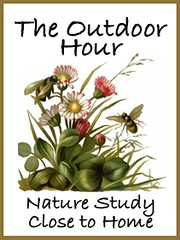We're starting a reading group on Ambleside Online Year 0, reading through the major sections of Comstock's Handbook of Nature Study. I thought it might be helpful to post my answers here for future reference:
Birds (ppgs. 26-35); Introduction & Lessons 1, 2 & 3
1. What discoveries are the goals of a true ornithologist?
The goals of a true ornithologist are not just to identify birds but to know their life habits.
2. Which birds should you start with when teaching your (Year 1 & up)
children?
Comstock suggests starting with chickens, pigeons, canaries, robins and bluebirds. After that she suggests studying birds that remain during the winter months, such as the chickadee, nuthatch and downy woodpecker.
3. What is nature’s method of shingling? Describe, please. (I guess
this means we have to do nature study in the rain sometimes!!!)
A bird's feathers overlap on its back and breast so that the rain, finding no place to enter, drips off, leaving the bird dry underneath.
4. What are the 3 parts of a feather?
The shaft or quill (the central stiff stem of the feather), the barbs (which towards the end join together to make a smooth web) and the fluff (which is at the base, near the bird's body).
5. What is down? What is a pin feather?
Down is a feather which doesn't have a quill. Young chicks are covered in down. A pin feather is a feather rolled up in a sheath, which will later break and allow the feather to unfold.
6. Where is a hen’s oil gland?
The oil gland is on her back, just at the base of the tail feathers.
7. How often does a hen shed her feathers (if at all)?
She sheds her feathers once a year.
8. What is the “leading thought” of the purpose of feathers (as
clothing), which will drive your study of them?
Some feathers act like raincoats, protecting against rain, wind and snow. Others act like underclothing, keeping the bird warm.
9. Comstock’s book gives a description of why birds are coloured as they
are from an evolutionary perspective; if you are a creationist, explain why
God may have created them the way they are.
Male birds are brightly coloured, since the female chooses the most beautiful to be her mate. Females are drab in comparison because they must hide their nest and young from predators and not attract attention. The young are also dull for this reason. The male birds sometimes use their colours (and songs) to distract attention away from where their hens and chicks are nesting.
10. Comstock gives several examples of beautiful birds. Are there any
birds you are particularly fond of for their beauty which are local to your
area?
We have turkey gobblers in our village who like to show off their plumage. There are a couple of male peacocks in the zoo too. I like the chaffinches in the park, as well as the woodpeckers and jays, which are also very beautiful to look at.
11. What do you have to teach a child about air before you teach him how
a bird flies (this might make a good Year 0 informal study)?
A child needs to understand that air is something that we can push against, or that can push against us. This can be done with a fan or an umbrella.
12. How are feathers on a wing especially suited for flying?
When the wing is open the wing quills overlap so that the air cannot pass through them. The wing is also slightly curved, as is each individual quill (so that it pushes against the air better). The wing feathers are also designed such that the barbs on the front edge are almost parallel with the quill (and therefore not offering resistance) whilst those on the back edge are more perpendicular, so as to form more of a web for the air to press against. When the wing pushes upwards for an 'up stroke' the quill bends at the joint so as to offer less resistance.
13. What is the leading thought about Feathers for Flying? Is Comstock
missing anything in her description of flying?
A bird flies by pressing down on the air with its wings, which are made specially for this purpose. The bird's tail acts as a rudder during flight.

